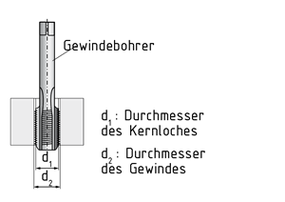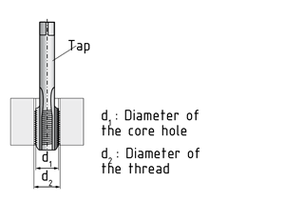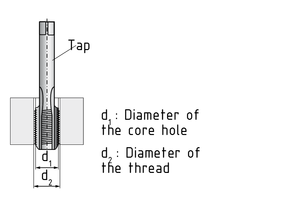
Seleccione uno
o más idiomas
0,1,3
- Alemán
- Inglés
- Chino
- Español
Roscado

El roscado es un proceso de corte de rosca de que usa una percusión para producir roscas internas. La percusión es a relieve para reducir el trabajo de fricción. Durante el proceso de roscado, los dientes en la punta de la percusión llevan a cabo la mayor parte de la acción de corte. El resto de la percusión, que es ligeramente cónica, sirve como guía.
El roscado se puede lograr ya sea por percusión a mano o mediante una máquina. La percusión a mano involucra un conjunto de percusiones, usualmente tres, cada una de las cuales lleva a cabo parte de la acción de roscado.
Primera percusión (50 %)
Segunda percusión (30 %)
Última percusión (acabado; 20 %)
El roscado por máquina usualmente involucra una sola percusión. Debido a la mala remoción de viruta, las condiciones de fricción no favorables y el riesgo asociado de ruptura de herramienta, los roscados de máquina trabajan a baja velocidad.
Percusión
Gewindebohren

Beim Gewindebohren, einem spanenden Schraubbohr-Fertigungsverfahren, werden mit einem Gewindebohrer Innengewinde hergestellt. Die Gewindebohrer sind hinterschliffen, damit die Reibarbeit verringert wird. Beim Bohren sorgt der Anschnitt des Bohrers für den Hauptteil der Zerspanung. Der übrige Teil des Gewindebohrers, der sich leicht verjüngt, sorgt für die Führung.
Gewindebohrer werden sowohl beim Hand- als auch beim Maschinenbohren eingesetzt. Der Handgewindebohrer besteht aus einem Satz von zumeist drei Bohrern, die jeweils einen Teil der Bohrarbeit übernehmen:
- Vorschneider (50 Prozent)
- Mittelschneider (30 Prozent)
- Fertigschneider (20 Prozent)
Maschinengewindebohrer sind meistens Einschnitt-Gewindebohrer. Wegen der schlechten Spanabfuhr, ungünstigen Reibungsverhältnissen und der damit verbundenen Werkzeugbruchgefahr sind beim maschinellen Gewindebohren niedrige Schnittgeschwindigkeiten nötig.
Tapping

Tapping is a Machining thread Cutting process that uses a tap to produce internal threads. The taps are relief-ground to reduce friction Work. During the tapping process, the teeth at the tip of the tap perform most of the cutting action. The rest of the tap, which is slightly tapered, serves as a guide.
Tapping can be achieved either by hand tapping or using a machine. Hand tapping involves a set of taps, usually three, each of which performs part of the tapping action:
- First tap (50 percent)
- Second tap (30 percent)
- Final (finish) tap (20 percent)
Machine tapping usually involves a single tap. Due to poor chip removal, unfavourable Friction conditions and the associated risk of tool breakage, machine taps work at low tapping speeds.
攻丝

攻丝是指使用旋塞生产内螺纹的切削螺纹工艺。旋塞经过铲磨以减少摩擦作用。在攻丝工艺中,旋塞端齿执行大多数的切割动作。旋塞其余部分稍微带有锥度,作为导套使用。
攻丝可以用手动或通过机器来实现。手工攻丝要使用一组旋塞,通常需要三个,其中每个执行攻丝行动的一部分:
头锥(50 %)
二锥(30 %)
精攻(20 %)
机械攻丝通常只需要单个旋塞。但由于排屑不畅,不利的摩擦条件和刀具破损的相关风险,在低速下执行机械攻丝。
旋塞
